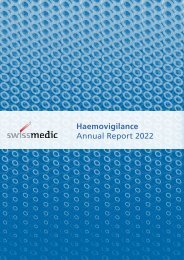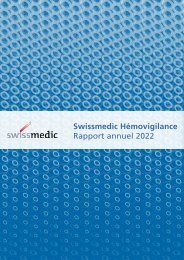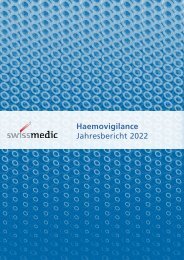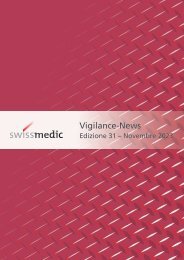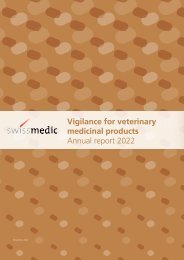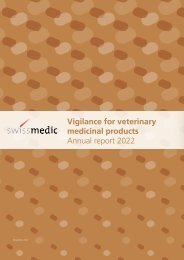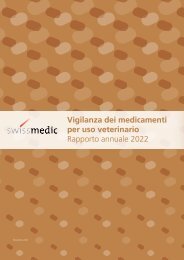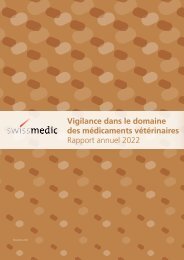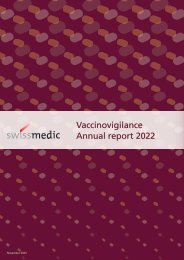Swissmedic Vigilance News Edition 20 – June 2018
Special issue: The history and development of pharma-covigilance in Switzerland over the last three decades
Special issue: The history and development of pharma-covigilance in Switzerland over the last three decades
You also want an ePaper? Increase the reach of your titles
YUMPU automatically turns print PDFs into web optimized ePapers that Google loves.
<strong>Vigilance</strong> <strong>News</strong><br />
<strong>Edition</strong> <strong>20</strong> <strong>–</strong> <strong>June</strong> <strong>20</strong>18<br />
Special issue<br />
The history and development of pharmacovigilance<br />
in Switzerland over the last<br />
three decades<br />
Sign up for emails<br />
Subscribe to <strong>Swissmedic</strong>'s <strong>Vigilance</strong> <strong>News</strong><br />
and register for the newsletter on drug<br />
safety! You will be constantly kept up to<br />
date by e-mail with information from the<br />
fields of pharmacovigilance (Health Professional<br />
Communication) and market monitoring<br />
(batch recalls, out-of-stock announcements):<br />
www.swissmedic.ch/newsletter-en<br />
Impressum<br />
Editorial team<br />
Martina Schäublin, Eva Eyal, Helena Bill<br />
Authors<br />
Rudolf Stoller, Eva Eyal<br />
We would like to thank all colleagues for<br />
their contribution to producing this edition of<br />
<strong>Swissmedic</strong> <strong>Vigilance</strong> <strong>News</strong>.<br />
Contact<br />
Please send any suggestions or feedback on this<br />
issue of <strong>Vigilance</strong> <strong>News</strong> to<br />
news.vigilance@swissmedic.ch.<br />
Report of an adverse drug<br />
reaction (ADR)<br />
<strong>Swissmedic</strong> recommends using the<br />
reporting portal (direct-entry or XML file<br />
upload)<br />
Online reporting portal ElViS:<br />
www.swissmedic.ch/elvis<br />
<strong>Swissmedic</strong> • Swiss Agency for Therapeutic Products • Hallerstrasse 7 • 3000 Bern 9 • Switzerland • www.swissmedic.ch
Contents<br />
Editorial 3<br />
Three decades of pharmacovigilance 4<br />
“It’s anecdotes“ 4<br />
The beginnings 4<br />
Metamizole versus aspirin <strong>–</strong> or<br />
comparing apples and oranges 6<br />
Hormonal contraceptives 7<br />
Drug-induced liver injury 7<br />
Risks in pregnancy 8<br />
Three decades of pharmacovigilance<br />
<strong>–</strong> a few conclusions 10<br />
Information on the <strong>Swissmedic</strong> website 12<br />
Healthcare Professional Communication 12<br />
Announcements 13<br />
<strong>Swissmedic</strong> <strong>Vigilance</strong> <strong>News</strong> | <strong>Edition</strong> <strong>20</strong> <strong>–</strong> <strong>June</strong> <strong>20</strong>18 2 | 14
Editorial<br />
Dear Reader<br />
Today you are receiving a special issue of<br />
<strong>Swissmedic</strong>’s <strong>Vigilance</strong> <strong>News</strong>.<br />
We normally report on current safety signals,<br />
individual case reports of adverse drug reactions<br />
(ADR) or recent Direct Healthcare Professional<br />
Communications (DHPC).<br />
This special issue focuses instead on the history<br />
and development of pharmacovigilance<br />
in Switzerland over the last three decades. A<br />
contemporary witness <strong>–</strong> Rudolf Stoller, Senior<br />
Expert and former Head of the Safety of Medicines<br />
division for many years <strong>–</strong> tells us of his<br />
own experiences. Although they occurred in<br />
the past, the examples he has chosen describe<br />
situations which still occur today and which illustrate<br />
the importance of drug safety in the<br />
patient <strong>–</strong> physician <strong>–</strong> medicinal product setting.<br />
Despite all the advances in good pharmacovigilance<br />
practices (GVP), we must never<br />
lose sight of one element: the patient around<br />
whom everything revolves. We are not simply<br />
dealing with numbers, but with human beings.<br />
We would like to thank the author, who will<br />
soon be embarking on his well-deserved retirement,<br />
for sharing his experiences with us<br />
and our readers, and offer him our best<br />
wishes for the future.<br />
The Editors<br />
<strong>Swissmedic</strong> <strong>Vigilance</strong> <strong>News</strong> | <strong>Edition</strong> <strong>20</strong> <strong>–</strong> <strong>June</strong> <strong>20</strong>18 3 | 14
Three decades of pharmacovigilance<br />
“It’s anecdotes“<br />
Created almost 30 years ago, the structures<br />
in the Swiss pharmacovigilance network<br />
have survived to this day. Since then, pharmacovigilance<br />
<strong>–</strong> both in Switzerland and internationally<br />
<strong>–</strong> has developed to an extent<br />
that those who were involved in its launch<br />
could hardly have imagined. But apart from<br />
a brief outline of the beginnings, we do not<br />
intend to trace this development here. Taking<br />
a few examples from everyday life <strong>–</strong> in<br />
the form of snapshots <strong>–</strong> I will merely illustrate<br />
certain aspects that I consider to be important<br />
or that were simply formative experiences,<br />
in a loose, random sequence in the<br />
spirit of the phrase that we often hear in<br />
pharmacovigilance: "It's anecdotes". However,<br />
these are, in fact, usually important<br />
stories told by patients and their relatives.<br />
Spontaneous reporting is a matter of learning<br />
from such stories for the next patient <strong>–</strong><br />
this "medicine-based evidence" and "evidence-based<br />
medicine" complement each<br />
other. They should not be played off against<br />
each other.<br />
The beginnings<br />
In 1990, the "IOCM Pharmacovigilance Centre"<br />
officially started work as an organisational<br />
unit of the Intercantonal Office for<br />
the Control of Medicines, IOCM, after a short<br />
pilot phase. As the regulatory body responsible<br />
for medicines in our country, the IOCM<br />
was the precursor of <strong>Swissmedic</strong>, which<br />
started in <strong>20</strong>02. There were three important<br />
elements:<br />
<br />
<br />
<br />
cooperation with the existing agencies<br />
and centres in Switzerland,<br />
cooperation with the "WHO Collaborating<br />
Centre for International Drug Monitoring"<br />
in Uppsala (now the Uppsala<br />
Monitoring Centre, UMC),<br />
the assessment of reports independently<br />
of companies.<br />
The IOCM Pharmacovigilance Centre collaborated<br />
with its official counterpart SANZ,<br />
the Swiss Drug Monitoring Centre in Chur,<br />
which had been established as a private<br />
foundation 11 years previously, in 1979. In<br />
1991 <strong>–</strong> at the same time as Nicaragua <strong>–</strong> the<br />
IOCM became the thirty third member of the<br />
"WHO Programme for International Drug<br />
Monitoring". The UMC and the network of<br />
sister authorities provided, and continue to<br />
provide, the crucial momentum.<br />
The IOCM Pharmacovigilance Centre relied<br />
primarily on reports of adverse drug reactions<br />
(ADR) submitted by the departments<br />
and units of clinical pharmacology in Swiss<br />
university hospitals. So, the reporting process<br />
occurred close to the patient and close<br />
to the treating physician, who would forward<br />
reports not to the authority, but to his<br />
colleagues in a university hospital of his<br />
choice, often his first or advanced training<br />
institution.<br />
The clinical pharmacologists, initially those<br />
in Geneva and Lausanne in particular, made<br />
a key contribution to the development of<br />
the network. To this day, the regional centres,<br />
in the French and German speaking<br />
part of Switzerland, later joined by the centre<br />
at Ospedale Civico in Lugano, still form<br />
the "Pharmacovigilance Network", which is<br />
firmly established in all linguistic regions of<br />
<strong>Swissmedic</strong> <strong>Vigilance</strong> <strong>News</strong> | <strong>Edition</strong> <strong>20</strong> <strong>–</strong> <strong>June</strong> <strong>20</strong>18 4 | 14
Switzerland. Another key factor was the inclusion<br />
of STIS (Swiss Teratogen Information<br />
Service) in Lausanne, which deals with Swiss<br />
reports of risks during pregnancy, and Tox<br />
Info Suisse in Zurich (cases of poisoning due<br />
to medicines).<br />
On 13 September 1991, the WHO confirmed Switzerland’s membership of the WHO International<br />
Drug Monitoring Programme to the IOCM.<br />
<strong>Swissmedic</strong> <strong>Vigilance</strong> <strong>News</strong> | <strong>Edition</strong> <strong>20</strong> <strong>–</strong> <strong>June</strong> <strong>20</strong>18 5 | 14
Metamizole versus aspirin <strong>–</strong> or<br />
comparing apples and oranges<br />
Metamizole <strong>–</strong> then<br />
At the start of the 1990s, the painkiller metamizole<br />
(Novaminsulfon) became a prescription-only<br />
medicine in Switzerland, Germany<br />
and certain other countries. A key reason for<br />
this was the risk of agranulocytosis, a complication<br />
classically referred to as a "type B"<br />
(bizarre) adverse drug reaction <strong>–</strong> unpredictable,<br />
occurring surprisingly, out of the blue<br />
and independently of dose. In addition <strong>–</strong> and<br />
considered even more dangerous <strong>–</strong> its mortality<br />
rate was put at around 10%. The largescale<br />
epidemiological investigation (Boston<br />
study) produced inconsistent results with differing<br />
odds ratios in various countries and<br />
regions. The same applies to the calculated<br />
incidences <strong>–</strong> one frequently cited definitive<br />
figure was 1:<strong>20</strong>,000.<br />
Aspirin, on the other hand, continues to be<br />
available over-the-counter <strong>–</strong> subject to the<br />
specified dosage strengths, dosages and<br />
pack sizes <strong>–</strong> even though gastrointestinal micro<br />
bleeding occurs in the majority of patients,<br />
and gastrointestinal ulcers, or even<br />
perforations, readily occur at higher cumulative<br />
doses in one in 1,000 treated individuals,<br />
in some cases with a fatal outcome.<br />
‣ So, despite its low incidence, the surprising<br />
and dose-independent occurrence of<br />
agranulocytosis proved to be the key factor<br />
in the decision to classify metamizole<br />
as a prescription-only medicine. It should<br />
be noted that aspirin was not included in<br />
this re-examination procedure. And it<br />
should be added that the comparison of<br />
the benefit-risk profile of the two active<br />
substances was, and continues to be<br />
problematic <strong>–</strong> as in many other situations<br />
where radical risk-minimising measures<br />
are involved.<br />
Metamizole <strong>–</strong> now<br />
Metamizole has since enjoyed growing popularity<br />
as a prescription-only medicine and is<br />
increasingly used, e.g. for postoperative<br />
pain. It is also often used in combination<br />
with paracetamol, although scant evidence<br />
is available to indicate a synergistic effect. As<br />
expected, increasing reports of agranulocytosis<br />
have also been recorded by <strong>Swissmedic</strong><br />
in recent years. A crucial factor in this context<br />
is that the diagnosis was only suspected<br />
at a late stage in some patients <strong>–</strong> fever, angina,<br />
ulcers in the mouth and genital and<br />
perineal area are warning signs that patients<br />
and healthcare professionals need to watch<br />
out for.<br />
‣ Pharmacovigilance is much more about<br />
dealing with risks inadequately taken<br />
into account in everyday clinical practice<br />
rather than dealing with new ADR.<br />
Warnings in the product information<br />
should be supplemented by regular reminders<br />
in order to raise awareness<br />
among a new generation of physicians<br />
and pharmacists. In its <strong>Vigilance</strong> <strong>News</strong>,<br />
<strong>Swissmedic</strong> has repeatedly reminded<br />
professionals about the necessary precautions<br />
when prescribing metamizole<br />
and the need to instruct patients accordingly.<br />
In <strong>20</strong>12, a publication in the "Swiss<br />
Medical Forum" addressed this subject<br />
(1); later articles on metamizole in this<br />
supplement to "Schweizerische Ärztezeitung"<br />
(Swiss medical journal) reiterated<br />
these important instructions.<br />
<strong>Swissmedic</strong> <strong>Vigilance</strong> <strong>News</strong> | <strong>Edition</strong> <strong>20</strong> <strong>–</strong> <strong>June</strong> <strong>20</strong>18 6 | 14
Hormonal contraceptives<br />
The scenario where the awareness of known<br />
risks declines and the risks in question need<br />
to be rediscovered is being repeated. Cases<br />
of venous thromboembolism associated with<br />
combined hormonal contraceptives are another<br />
example. This risk was the subject of<br />
public discussion even in the years following<br />
the introduction of the pill (when it still contained<br />
a high oestrogen dose), and became<br />
a hot media topic again in 1995. At that<br />
time, contrary to expectations, epidemiological<br />
studies showed a doubling of the risk for<br />
the modern third-generation preparations<br />
compared to that for the second-generation<br />
contraceptives. Some countries even experienced<br />
a veritable "pill scare". A similar situation<br />
occurred when, after <strong>20</strong>09, combined<br />
pills containing drospirenone <strong>–</strong> a progestogen<br />
with anti-androgenic properties <strong>–</strong> were<br />
associated with an increased risk of thromboembolism.<br />
This year, in addition to the<br />
known psychiatric side effects (including depression),<br />
a possible effect on the suicide risk<br />
is being evaluated. It almost seems as if every<br />
generation has to rediscover certain ADR.<br />
Drug-induced liver injury<br />
Beclobrate <strong>–</strong> or the lucky blood donor<br />
In 1990, 5 years after beclobrate was authorised,<br />
we received two reports of irreversible<br />
liver failure with a fatal outcome in patients<br />
taking this new fibrate-based lipid-lowering<br />
drug. The substance was authorised only in<br />
Switzerland and had a limited market volume<br />
at that time. A DHPC (Direct Healthcare<br />
Professional Communication) drew the attention<br />
of healthcare professionals to this<br />
new risk, which had not been identified<br />
from the clinical trial data, and specified corresponding<br />
precautionary measures. Shortly<br />
thereafter, we received a report about a<br />
young male patient who showed greatly elevated<br />
transaminase levels shortly after<br />
starting treatment with beclobrate. He had<br />
not shown any symptoms of illness, and the<br />
abnormal liver enzyme levels had been discovered<br />
during screening for a blood donation<br />
<strong>–</strong> he was a regular blood donor. They<br />
returned to normal after the drug was discontinued,<br />
and the drug remained the only<br />
plausible cause.<br />
‣ We can assume that he had been spared<br />
a serious, possibly life-threatening, episode<br />
of drug-induced hepatitis thanks to<br />
this chance finding. Not just him, but<br />
other patients as well <strong>–</strong> the three postmarketing<br />
reports of severe liver injuries<br />
in a still limited patient population had<br />
been sufficient to cause beclobrate to be<br />
withdrawn from the market, since it was<br />
not a life-saving drug and since therapeutic<br />
alternatives were available.<br />
Conflicting messages <strong>–</strong> or what does<br />
negative re-exposure mean?<br />
There have also been reports, this time at<br />
the international level in Switzerland and<br />
the USA, of several patients with serious,<br />
and in some cases fatal, drug-induced liver<br />
injury, who had received a new antiparkinsonian<br />
drug shortly after its market launch.<br />
Adverse effects on the liver had already<br />
been known at the time of authorisation. A<br />
rise in transaminase levels to more than<br />
three times the upper limit of normal had<br />
been observed in 1% of patients in clinical<br />
trials. The product information therefore<br />
called for regular monitoring of liver enzymes.<br />
However, this warning was followed<br />
by a sentence stating that, in clinical trials,<br />
the transaminase levels returned to normal<br />
in those patients who continued the treatment<br />
despite elevated levels.<br />
‣ The post-marketing reports then showed<br />
that the monitoring had not been carried<br />
out consistently in some patients <strong>–</strong> not<br />
surprising in view of the difficulties associated<br />
with a visit to the physician for<br />
some Parkinson patients. However, the<br />
<strong>Swissmedic</strong> <strong>Vigilance</strong> <strong>News</strong> | <strong>Edition</strong> <strong>20</strong> <strong>–</strong> <strong>June</strong> <strong>20</strong>18 7 | 14
conflicting message in the product information<br />
has probably also been a contributory<br />
factor. While the reference to the<br />
"negative rechallenge" was supported<br />
by data for some patients, it wrongly<br />
called into question the need for discontinuation.<br />
On the other hand, this section<br />
should not give the impression that monitoring<br />
of the liver enzymes <strong>–</strong> for example<br />
on a monthly basis <strong>–</strong> will detect liver<br />
injury at a sufficiently early stage. It cannot<br />
always prevent life-threatening, subfulminant<br />
and fulminant courses.<br />
Risks in pregnancy<br />
A conference in Berlin at the end of the<br />
1990s reflected whether a thalidomide catastrophe<br />
would still be possible today. In<br />
view of the developments in drug safety<br />
since the 1960s, prompted specifically by the<br />
thalidomide disaster, the answers were<br />
largely reassuring. It did emerge, however,<br />
that teratogenic risks are no longer accorded<br />
such a high priority in pharmacovigilance<br />
decades after the scandal. This was partly<br />
due to the creation, in the interim, of corresponding<br />
specialist centres, databases, registers<br />
and epidemiological methods.<br />
The fact that the connection between developmental<br />
disorders in children and maternal<br />
exposure to valproate in pregnancy was only<br />
detected at a late stage, roughly a decade<br />
after the malformation risk was identified,<br />
and that the severity and frequency of developmental<br />
disorders were only noticed<br />
even later <strong>–</strong> as a result of the NEAD study<br />
published in <strong>20</strong>13 (2) <strong>–</strong> has now led to serious<br />
questions that need to be addressed by all<br />
concerned.<br />
To date, there have been 24 reports in Switzerland<br />
of serious developmental disorders<br />
in children and adolescents, specifically concerning<br />
mental and psychological development,<br />
including autism and related disorders.<br />
While most of these were reported after<br />
the information campaign in <strong>20</strong>15, some<br />
involve disorders that manifested themselves<br />
years beforehand. Which factors have<br />
delayed the detection of this signal and the<br />
risk-minimising measures <strong>–</strong> both internationally<br />
and in Switzerland <strong>–</strong> and what can we<br />
learn from this?<br />
What were the contributory factors?<br />
• The risk was difficult to detect <strong>–</strong> long latency<br />
period and low "drug-attributable<br />
fraction of risk":<br />
- Developmental disorders in children<br />
only manifest themselves years after<br />
the maternal exposure; this connection<br />
is not directly apparent. This contrasts<br />
with teratogenic risks in the stricter<br />
sense, which are detected as malformations<br />
during pregnancy or shortly<br />
after birth.<br />
- Disorders of psychomotor development<br />
are multifactorial, and genetic<br />
and psychosocial causes are usually the<br />
first factors to be considered. Drugs<br />
tend to remain in the background as<br />
possible causes.<br />
The spontaneous reporting system usually<br />
reacts sensitively and quickly to new risks,<br />
even rare ones. However, it has its limitations<br />
when it comes to ADR that manifest<br />
themselves at a late stage <strong>–</strong> often termed<br />
"type D" (delayed) reactions, e.g. carcinogenicity.<br />
The same applies to illnesses that<br />
are not usually caused by drugs and therefore<br />
show a low drug attributable fraction<br />
of risk. A classic example would be<br />
cardiovascular risks and the corresponding<br />
market withdrawal of Vioxx ®<br />
(rofecoxib) in <strong>20</strong>05.<br />
<strong>Swissmedic</strong> <strong>Vigilance</strong> <strong>News</strong> | <strong>Edition</strong> <strong>20</strong> <strong>–</strong> <strong>June</strong> <strong>20</strong>18 8 | 14
• Advances in the ultrasound monitoring of<br />
pregnancy may have raised expectations<br />
that malformations can be reliably detected<br />
and that this known risk of the<br />
substance is therefore "under control".<br />
This probably lowered the inhibition<br />
threshold for using valproate in pregnancy.<br />
• Prescribing practice has been slow to respond<br />
to the development of new antiepileptic<br />
agents. Whereas the available<br />
alternatives such as phenytoin and carbamazepine<br />
were also associated with<br />
teratogenic risks back in the early 1990s<br />
(albeit to a lesser extent than valproate),<br />
these were followed by the arrival on the<br />
market of new drugs that were considered<br />
to be less harmful and, still later, also<br />
much safer in respect of neurological developmental<br />
disorders.<br />
• Antiepileptic drugs very often constitute<br />
a long-term treatment. Possible problems<br />
in the event of a future pregnancy should<br />
be considered and addressed even when<br />
they are prescribed to adolescents. Wherever<br />
possible, exposure in pregnancy<br />
should be avoided and the treatment<br />
switched beforehand.<br />
the drug long before this is confirmed by<br />
epidemiological results.<br />
• Prescribing practice in this context is crucial.<br />
This should be taken into account<br />
and followed up as part of the risk management<br />
plan.<br />
• Established prescribing habits are difficult<br />
to change. Agencies such as professional<br />
associations, universities, patient organisations<br />
and cantonal authorities are important<br />
players in achieving a successful<br />
outcome. According to a study in the EU,<br />
the repeated tightening of restrictions in<br />
the case of valproate <strong>–</strong> warnings in the<br />
product information, DHPC, instruction<br />
materials, acknowledgement form for patients,<br />
subsequently supplemented by a<br />
patient card and pictogram on the pack <strong>–</strong><br />
failed to work as hoped. We have isolated<br />
examples of this in Switzerland as well. To<br />
prevent unplanned pregnancies occurring<br />
under treatment with valproate effectively<br />
and across the board, requires a<br />
comprehensive programme that is comparable<br />
with the one implemented for<br />
oral retinoids for the treatment of acne<br />
and that involves physicians, pharmacists<br />
and patients.<br />
Lessons for the future<br />
• The more surprising and serious an ADR<br />
is, the more attention it merits, particularly<br />
if the causality is initially called into<br />
question, which is often the case with unusual<br />
risks.<br />
• In retrospect, as regards developmental<br />
disorders and valproate, more attention<br />
should have been paid to one aspect that<br />
should always be noted in spontaneous<br />
reporting: developmental disorders associated<br />
with valproate often involve characteristic<br />
signs of dysmorphia, particularly<br />
of the face. Such a specific pattern is a<br />
strong indication of a causative role of<br />
<strong>Swissmedic</strong> <strong>Vigilance</strong> <strong>News</strong> | <strong>Edition</strong> <strong>20</strong> <strong>–</strong> <strong>June</strong> <strong>20</strong>18 9 | 14
Three decades of pharmacovigilance <strong>–</strong> a few conclusions<br />
Pharmacovigilance is designed to help patients. These are not<br />
"cases", not even "interesting cases" or "clinical pearls", to quote<br />
one description still used in medical training events. Patients come<br />
to us with questions about their <strong>–</strong> often serious <strong>–</strong> conditions, and<br />
with the aim of sparing other patients a similar scenario. One patient<br />
who had contacted an authorisation holder about a disabling ADR<br />
and raised the question of compensation, reported that the company<br />
had sent over a lawyer. He summed up his disappointment with<br />
this encounter with the following words: "if there had just been one<br />
word of compassion…"<br />
"Subjective ADR" should not be viewed less seriously than "objective"<br />
ones. The assessment should never question the existence of<br />
the symptom <strong>–</strong> e.g. loss of hypoglycaemia warning symptoms with<br />
human insulins, or depression progressing to suicidal thoughts with<br />
oral retinoids <strong>–</strong> but should rather focus on the connection with the<br />
drug. If the symptoms recur when the drug is re-administered to<br />
some patients, then this counts as weighty "medicine-based evidence".<br />
However, the psychiatric problems that are connected with<br />
oral retinoids also illustrate how difficult it is to distinguish between<br />
the role of risk factors <strong>–</strong> particularly the problems of adolescence <strong>–</strong><br />
and the drug itself. The medicine then becomes just one of the factors<br />
to be taken into account. Therefore, it is not sufficient to discontinue<br />
the retinoid; rather, the psychiatric symptoms often require<br />
specific investigation and treatment.<br />
Most ADR are dose-dependent. The inadequate adaptation of the<br />
dose to kidney function is still one of the principal causes of ADR.<br />
The product information is designed to guide the prescriber before<br />
a drug is administered and, if necessary, during the treatment. In<br />
addition to important ADR, therefore, important warning symptoms<br />
should also be listed. For erythema exsudativum multiforme/toxic<br />
epidermal necrolysis (TEN), a reference should be made,<br />
for example, to previous fever and to painful, spreading skin lesions<br />
followed by blister formation. The symptoms of agranulocytosis<br />
have already been mentioned. And however banal it might seem:<br />
whenever drugs that frequently lead to anaphylaxis or other serious<br />
hypersensitivity reactions are administered, the patient should always<br />
be asked how well the last administration was tolerated. Seen<br />
from this standpoint, it is not correct to state that type B reactions<br />
are "not predictable" or that "no risk factors" are involved.<br />
<strong>Swissmedic</strong> <strong>Vigilance</strong> <strong>News</strong> | <strong>Edition</strong> <strong>20</strong> <strong>–</strong> <strong>June</strong> <strong>20</strong>18 10 | 14
Let us leave the last word to two great<br />
women, both unfortunately deceased:<br />
Drug safety also involves informing the public<br />
objectively about the risks associated with<br />
therapeutic products <strong>–</strong> author Rudolf Stoller taking<br />
part in “Patti Chiari”, the consumer affairs<br />
programme broadcast by RSI, Switzerland’s Italianlanguage<br />
TV channel. A report entitled “Pericolo in<br />
pillole” discussed the risks to unborn children of<br />
exposure to the highly teratogenic active substance<br />
isotretinoin.<br />
Kathrin Mühlemann, the former director of<br />
the Institute for Infectious Diseases and a<br />
professor at the University of Bern, liked to<br />
describe herself as the "professor of<br />
handwashing", since this simple measure<br />
achieves so much in her field. It is also true in<br />
pharmacovigilance that the important things<br />
are simple.<br />
Winifred Castle, MD and FFPM (Fellow of Faculty<br />
of Pharmaceutical Medicine), played a<br />
key role in the development of pharmacovigilance<br />
before and after the turn of the century<br />
in various companies, for example as<br />
"Vice-President International Drug Surveillance"<br />
in the then Glaxo Inc. She was also involved<br />
in CIOMS Working Groups. Long before<br />
we would talk about integrating the<br />
safety of drugs and their safe use, she put the<br />
purpose of pharmacovigilance in a nutshell:<br />
“Be helpful!“<br />
Literature<br />
(1) Theiler R, Wyrisch B. Rationale Schmerztherapie <strong>–</strong><br />
oder doch nicht? Schweiz Med Forum.<br />
<strong>20</strong>12;12:645<strong>–</strong>51<br />
(2) Meador KJ et al. Fetal antiepileptic drug exposure<br />
and cognitive outcomes at age 6 years (NEAD<br />
study): a prospective observational study. Lancet<br />
Neurol. <strong>20</strong>13 March;12(3):244<strong>–</strong>252.<br />
doi:10.1016/S1474-4422(12)70323-X.<br />
<strong>Swissmedic</strong> <strong>Vigilance</strong> <strong>News</strong> | <strong>Edition</strong> <strong>20</strong> <strong>–</strong> <strong>June</strong> <strong>20</strong>18 11 | 14
Information on the <strong>Swissmedic</strong> website 1<br />
Healthcare Professional Communication<br />
09.05.<strong>20</strong>18<br />
DHPC <strong>–</strong> Klacid ® / Klaciped ® (Clarithromycin)<br />
Interaktionen von Clarithromycin mit Domperidon<br />
13.04.<strong>20</strong>18<br />
DHPC <strong>–</strong> Encepur N, Encepur N Kinder, Td-pur<br />
Naturkautschuklatex in der Nadelschutzkappe<br />
der Fertigspritze mit fixer Injektionsnadel<br />
13.04.<strong>20</strong>18<br />
DHPC <strong>–</strong> Information on leaking syringes of various<br />
GSK vaccines<br />
GlaxoSmithKline AG has provided information on<br />
syringe leaks that may occur with various vaccines<br />
during reconstitution or administration.<br />
09.04.<strong>20</strong>18<br />
DHPC <strong>–</strong> Vancomycin<br />
Vancomycin: Einschränkungen der Indikationen<br />
für die orale Anwendung sowie neues angepasstes<br />
Dosierungsschema nach Alter und Gewicht für<br />
die intravenöse Anwendung<br />
04.04.<strong>20</strong>18<br />
DHPC <strong>–</strong> Buccolam (Midazolam)<br />
Wichtige sicherheitsrelevante Information <strong>–</strong> möglicher<br />
Produktemangel<br />
29.03.<strong>20</strong>18<br />
DHPC <strong>–</strong> Hinweise zur korrekten Anwendung von<br />
Parsabiv ® (Etelcalcetide)<br />
Bei dialysepflichtigen Patienten mit chronischer<br />
Nierenerkrankung<br />
28.03.<strong>20</strong>18<br />
DHPC <strong>–</strong> Insuman ® Infusat (Humaninsulin)<br />
Einstellung der Vermarktung am 4. Mai <strong>20</strong>18<br />
21.03.<strong>20</strong>18<br />
DHPC <strong>–</strong> Actemra ® (Tocilizumab)<br />
Berichte über interstitielle Lungenerkrankungen<br />
15.03.<strong>20</strong>18<br />
DHPC <strong>–</strong> Esmya ® (Ulipristal)<br />
Anwendungseinschränkungen, neue Warnhinweise<br />
bezüglich schwerer Leberschäden und<br />
Empfehlungen zur Überwachung<br />
13.03.<strong>20</strong>18<br />
DHPC <strong>–</strong> Zinbryta ® Fertigspritze, Fertigpen (DACLI-<br />
ZUMAB beta)<br />
Widerruf der Zulassung in der Schweiz<br />
02.03.<strong>20</strong>18<br />
HPC <strong>–</strong> MS-Medikament Zinbryta ® wird international<br />
vom Markt genommen<br />
<strong>Swissmedic</strong> wurde über neue schwerwiegenden<br />
Nebenwirkungen in Verbindung mit dem Präparat<br />
Zinbryta (Wirkstoff Daclizumab) informiert.<br />
31.01.<strong>20</strong>18<br />
DHPC <strong>–</strong> Zinbryta (DACLIZUMAB beta) Fertigspritze<br />
/ Fertigpen<br />
Einschränkung der Anwendung aufgrund des Risikos<br />
von fulminantem Leberversagen und Anpassung<br />
der Arzneimittelinformation<br />
29.01.<strong>20</strong>18<br />
HPC <strong>–</strong> Systemisch angewendete Fluorochinolone<br />
Wichtige Anwendungseinschränkungen aufgrund<br />
des Sicherheitsprofiles<br />
<strong>20</strong>.01.<strong>20</strong>18<br />
DHPC <strong>–</strong> Ofev ® (Nintedanib)<br />
Schwere Leberschäden und die Notwendigkeit einer<br />
regelmässigen Überwachung der Leberfunktion<br />
18.01.<strong>20</strong>18<br />
HPC <strong>–</strong> Iberogast ® Tinktur<br />
Risiko von Leberschädigungen: Anpassung der<br />
Arzneimittelinformation<br />
04.01.<strong>20</strong>18<br />
DHPC <strong>–</strong> VELCADE ® 3.5mg, Lyophilisat<br />
Wichtige sicherheitsrelevante Information<br />
1<br />
Most of the links are available in German/French only<br />
<strong>Swissmedic</strong> <strong>Vigilance</strong> <strong>News</strong> | <strong>Edition</strong> <strong>20</strong> <strong>–</strong> <strong>June</strong> <strong>20</strong>18 12 | 14
22.12.<strong>20</strong>17<br />
DHPC <strong>–</strong> Eligard ® (Leuprorelinacetat)<br />
Medikationsfehler in Zusammenhang mit Flüssigkeitsaustritt<br />
aufgrund Überdrehens der Sicherheitsnadel<br />
21.12.<strong>20</strong>17<br />
DHPC <strong>–</strong> Fiasp ® ultra-fast-acting (Insulin Aspart)<br />
und Tresiba ® 100E/ml (Insulin Deglutec)<br />
Verwechslungsgefahr des schnell wirkenden<br />
Mahlzeiten-Insulins mit dem langwirkenden Basalinsulin<br />
14.12.<strong>20</strong>17<br />
DHPC <strong>–</strong> Xofigo ® (Radium-223-Dichlorid)<br />
Erhöhtes Todesfall- und Frakturrisiko in einer randomisierten<br />
klinischen Studie zu Xofigo in Kombination<br />
mit Abirateronacetat und Prednison/Prednisolon<br />
17.11.<strong>20</strong>17<br />
DHPC <strong>–</strong> Dantrolen i.v., Injektionslösung<br />
Die Firma Norgine AG informiert über wichtige,<br />
die Anwendung von Dantrolen i.v., Injektionslösung<br />
betreffende Änderungen.<br />
16.11.<strong>20</strong>17<br />
DHPC <strong>–</strong> Buccolam (Midazolam Hydrochlorid)<br />
Wichtige sicherheitsrelevante Information <strong>–</strong> möglicher<br />
Produktemangel<br />
Announcements<br />
23.05.<strong>20</strong>18<br />
Reclassification of medicinal products: status update<br />
Project to reclassify medicinal products in other<br />
dispensing categories in connection with the revision<br />
of the Therapeutic Products Act.<br />
<strong>20</strong>.04.<strong>20</strong>18<br />
Warning about the dietary supplement Liquid<br />
XXX<br />
Dietary supplement with vitamins as liquid concentrate<br />
04.04.<strong>20</strong>18<br />
New Information sheet on Drug Safety Signals<br />
MU101_<strong>20</strong>_005e_MB Drug Safety Signals<br />
03.04.<strong>20</strong>18<br />
<strong>Swissmedic</strong> has a new Executive Director <strong>–</strong> new<br />
leadership team complete<br />
Raimund Bruhin takes up his post.<br />
<strong>20</strong>.03.<strong>20</strong>18<br />
<strong>Swissmedic</strong> opens the consultation procedure on<br />
the amendment of ordinances of the Swiss Agency<br />
for Therapeutic Products in connection with the<br />
implementation of the Medicrime Convention<br />
Draft consolidation legislation: Agency Council<br />
MPLO/Medicrime Ordinance<br />
01.03.<strong>20</strong>18<br />
19 new psychoactive substances added to Narcotics<br />
List<br />
Press release<br />
08.02.<strong>20</strong>18<br />
Statistics illegally imported medicinal products<br />
<strong>20</strong>17<br />
In <strong>20</strong>17, 1,060 shipments of illegally imported<br />
therapeutic products were seized, including medically<br />
important medicinal products that are subject<br />
to strict prescribing limits.<br />
08.01.<strong>20</strong>18<br />
Launch of eGov CPP service on 8 January <strong>20</strong>18<br />
With immediate effect, e-mail orders will no<br />
longer be accepted.<br />
18.12.<strong>20</strong>17<br />
ICH Meeting in Geneva, Switzerland, 11<strong>–</strong>16 November<br />
<strong>20</strong>17<br />
ICH decision on multi-regional clinical trials aims<br />
to benefit public health<br />
08.12.<strong>20</strong>17<br />
Federal Council appoints new member of the<br />
Agency Council<br />
The Federal Council has appointed Marie-Denise<br />
Schaller to the Agency Council.<br />
07.12.<strong>20</strong>17<br />
Good Manufacturing Practice (GMP)<br />
Procedure for discrepancies between EU and PIC/S<br />
GMP<br />
<strong>Swissmedic</strong> <strong>Vigilance</strong> <strong>News</strong> | <strong>Edition</strong> <strong>20</strong> <strong>–</strong> <strong>June</strong> <strong>20</strong>18 13 | 14
15.11.<strong>20</strong>17<br />
The Swiss Federal Council appoints Raimund<br />
Bruhin as new Executive Director of <strong>Swissmedic</strong><br />
Media release<br />
15.11.<strong>20</strong>17<br />
New indications - faster access for patients to medicines<br />
Report of the Swiss Federal Council on the postulate<br />
16.4096<br />
13.11.<strong>20</strong>17<br />
Umteilung von Arzneimitteln in andere Abgabekategorien<br />
Stand der Arbeiten<br />
08.11.<strong>20</strong>17<br />
New forms for prescription of narcotics by medical<br />
professionals<br />
The forms for prescription of narcotics by medical<br />
professionals have been amended.<br />
06.11.<strong>20</strong>17<br />
As of 8 January <strong>20</strong>18: product certificates (CPP) to<br />
be ordered exclusively via eGov CPP service<br />
The definitive changeover to the eGov CPP<br />
The complete list is available at the following<br />
web address www.swissmedic.ch/updates-en<br />
<strong>Swissmedic</strong> <strong>Vigilance</strong> <strong>News</strong> | <strong>Edition</strong> <strong>20</strong> <strong>–</strong> <strong>June</strong> <strong>20</strong>18 14 | 14




